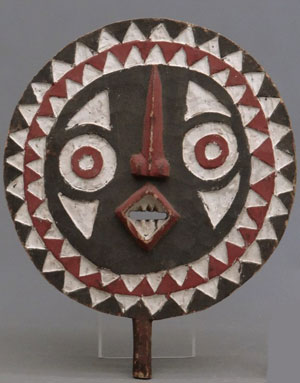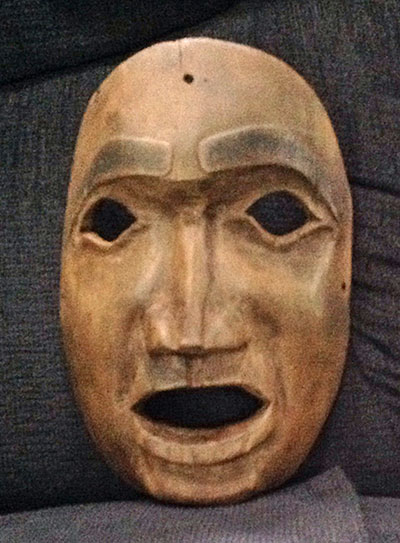 Q: Found at town dump in a small town with old families. Fred, 1466
Q: Found at town dump in a small town with old families. Fred, 1466
A: I just posted one of these September 26, 2018. It was an old, used example from the Met. Yours is a new one of good quality, possibly meant for use or sale. It has high value because water spirit headdresses from the Ijebu (also spelled Ijaw, Ijo) are hard to find.
“Water deities are perceived to be the forces ultimately responsible for individual acquisition of wealth and power. Among the Kalabari, an Ijo subgroup that occupies the eastern part of the delta, one of the most important village institutions is the Ekine society, an association devoted to the dancing of masquerades representing water spirits. It is claimed that these performances imitate dances of the water spirits themselves, and the masks sometimes exit or enter from the water. Often the masquerade headpieces are designed so that the principal features face the sky and are visible to spectators only when the dancer bends forward in the river.
“This water spirit headdress is used in the masquerades of the Ekine men’s society (also Sekiapu). The headdresses worn in such performances blend the features of humans and aquatic animals (such as the hippopotamus) or fish. Although they are worn with a cloth and palm costume that covers the entire body, the headdress is the key element which is conceived of as the seat of the masquerade spirit’s “owner.” Ekine performances constitute a highly appreciated form of entertainment and invoke local water spirits for assistance and guidance. Skilled performers gain status in the community and are also the arbitrators of personal disputes.” (from the Metropolitan Museum) A








One Comment
Bob Ibold
The next day I got this reply from Fred…
Appreciate your comments on my found mask, but I am unable to fathom why you characterize it as Nigerian Water related. It has all the features of typical Ivory Coast . Have found dozens of references. See https://goo.gl/images/7hPGA9
The Mask Man was wrong– this headdress is more likely a Firespitter from the Senufo people of Ivory Coast, Mali or Burkina Fasso. There they are called.Kponungo, or “funeral head masks.” The term “Firespitter” is used by outsiders.
The Poro and non-Poro male societies wear these helmet masks to embodied an aggressive supernatural power to combat any forces that might disrupt the well-being of the community. The powerful features of antelopes, buffaloes, crocodiles, warthogs, hornbills, chameleons and humans combined to symbolize power and to recall important myths. They were used in anti-witchcraft ceremonies.
I’m sorry for this mistake. I try to deal with all cultures that use masks, not just in Africa, but every where. Of course, that is an impossible task.